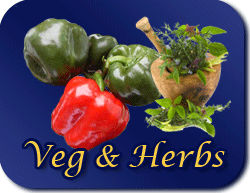Growing vegetables in containers, whether inside your home, a conservatory or green-house, has many advantages when compared to an in-ground veg patch garden. Maintaining the soil is easier but perhaps the biggest advantage is that pest control becomes far less of a problem also. There is also more flexibility for re-locating your vegetable place to suit the temperature or light levels, and being able to treat your plants differently and separately from each other.
The vast majority of outdoor vegetable varieties will grow perfectly well in pots. Pumpkins and cucumbers might not be the best choices due to the size container you would require, but tomatoe plants, peas, chills and peppers, carrots and many others root vegetables will grow equally as well if not better in containers such as pots and planters, and herbs would be more than happy in old plastic milk bottles with the tops chopped off, and some drainage holes. You could even try a small vertical garden by tying these milk bottle plants to a post or piece of drain pipe, which is an excellent way to save space. (More about vertical gardening to come in a subsequent guide).
Please ensure that you select a growing container that is large enough for the fully grown plant/s. Try to maintain weed free soil and add organic fertiliser, before adding your plants to the container. Synthetic soil-like media are an option, however mixtures of peat moss, perlite, wood chips and others can be a good choice for a variety of species.
Preparing the soil beforehand, or using a synthetic medium, also provides the added benefit of enhanced water control, and providing sufficient drainage which is balanced with the retention of moisture is especially advantageous for healthy container-grown vegetable gardens. Breaking up clay particles is easy by mixing in commercial soil prep. Put some stone or broken pottery at the bottom of a container to ensure good drainage and to stop the holes from becoming clogged by the growing medium.
It goes without saying that you will need to water your veg plant containers with diligence as the soil can quickly dry out when containers in hot conditions. Consider having a daily check list to avoid forgetting whether it has been done. However, also be sure not to over-water your veg plants as it is easy to introduce root rot, especially if drainage is not sufficient. The soil should be moist to the touch at all times, and it is easy to identify plants which desperately need watering, by the drooping of leaves or simply the dried cracked surface of the compost. However you may which to consider obtaining a soil moisture tester.
In most cases, soil dug straight from your garden or elsewhere, is not the best choice for any veg garden. It is far less problematic to buy professionally prepared compost or grow bags.
Most variety of vegetable grow best in a lot of sun-light. Growing tomatoes in a south-facing position that receives light for at least several hours each day will help the plants and your resulting crop greatly. Tomatoes also Like a warm environment so there is very little risk of burning. But some varieties, such as lettuce plants, grow best when a little shadier, where there is less direct sun-light. However, with container vegetable gardening, you can move your plants if necessary, perhaps on those days when the weather is not helping the matter!
Despite being less of a problem, stay alert for insects and pests in a container garden, as you would with any other form of gardening. Vegetable plant containers situated outdoor obviously allows nature to roam amongst your crop. But even indoors in a conservatory or garden green-house, many small pests can easily navigate through screen mesh or cracks in the doors and windows. Sometimes, eggs may have been laid in the soil prior to planting, another argument for using fresh professional compost each year.
Vegetable gardening in containers requires some effort, but on a small scale it is the preferred method, and can make a vegetable garden more attractive to look at. And obviously it is also very rewarding to have fresh vegetables on hand, providing you with a tasty and healthy home-grown food source and a better diet for it. Also, I swear by may claims that when you grow it yourself, pick, wash and cook it fresh, home-grown vegetables will taste far better than anything you can pick up at a super market.
So why not try a small container grown vegetable plant or herb garden yourself this year?

